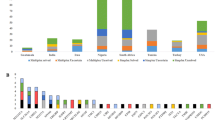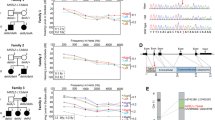Abstract
From a large collection of families with autosomal recessive non-syndromic hearing impairment (NSHI) from Pakistan, linkage has been established for two unrelated consanguineous families to 19p13.2. This new locus was assigned the name DFNB68. A 10 cM genome scan and additional fine mapping were carried out using microsatellite marker loci. Linkage was established for both families to DFNB68 with maximum multipoint LOD scores of 4.8 and 4.6. The overlap of the homozygous regions between the two families was bounded by D19S586 and D19S584, which limits the locus interval to 1.9 cM and contains 1.4 Mb. The genes CTL2, KEAP1 and CDKN2D were screened but were negative for functional sequence variants.



Similar content being viewed by others
References
Abecasis GR, Cherny SS, Cookson WO, Cardon LR (2002) Merlin: rapid analysis of densegenetic maps using sparse gene flow trees. Nat Genet 30:97–101
Broman K, Murray JC, Scheffield VC, White RL, Weber JL (1998) Comprehensive humangenetic maps: individual and sex specific variation in recombination. Am J Hum Genet 63:861–869
Chen A, Wayne S, Bell A, Ramesh A, Srisailapathy CRS, Scott DA, Sheffield VC, Van Hauwe P, Zbar RIS, Ashley J, Lovett M, Van Camp G, Smith RJH (1997) New gene for autosomal recessive non-syndromic hearing loss maps to either chromosome 3q or 19p. Am J Med Genet 71:467–471
Chen AH, Stephan DA, Hasson T, Fukushima K, Nelissen CM, Chen AF, Jun AI, Ramesh A, Van Camp G, Smith RJ (2001) MYO1F as a candidate gene for nonsyndromic deafness, DFNB15. Arch Otolaryngol Head Neck Surg 127:921–925
Chen P, Zindy F, Abdala C, Liu F, Li X, Roussel MF, Segil N (2003) Progressive hearing loss in mice lacking the cyclin-dependent kinase inhibitor Ink4d. Nat Cell Biol 5:422–426
Cottingham R, Indury RM, Schaffer AA (1993) Faster sequential genetic linkage computations. Am J Hum Genet 53:252–263
Freimer NB, Sandkuijl LA, Blower SM (1993) Incorrect specification of marker allele frequencies: effects on linkage analysis. Am J Hum Genet 52:1102–1110
Grimberg J, Nawoschik S, Bellusico L, McKee R, Turck A, Eisenberg A (1999) A simple and efficient non-organic procedure for the isolation of genomic DNA from Blood. Nucleic Acid Res 17:83–90
Gudbjartsson DF, Jonasson K, Frigge ML, Kong A (2002) Allegro, a new computer program for multipoint linkage analysis. Nat Genet 25:12–13
Holme RH, Bussoli TJ, Steel KP (2002) Table of gene expression in the developing ear. URL: http://www.ihr.mrc.ac.uk/Hereditary/genetable/index.shtml
Ichimiya I, Yoshida K, Suzuki M, Mogi G (2003) Expression of adhesion molecules by cultured spiral ligament fibrocytes stimulated with proinflammatory cytokines. Ann Otol Rhinol Laryngol 112:722–728
International Human Genome Sequence Consortium (2001) Initial sequence and analysis of the human genome. Nature 409:860–921
Kong X, Murphy K, Raj T, He C, White PS, Matise TC (2004) A combined linkage-physical map of the human genome. Am J Hum Genet 75:1143–1148
Nair TS, Kozma KE, Hoefling NL, Kommareddi PK, Ueda Y, Gong TW, Lomax MI, Lansford CD, Telian SA, Satar B, Arts HA, El-Kashlan HK, Berryhill WE, Raphael Y, Carey TE (2004) Identification and characterization of choline transporter-like protein 2, an inner ear glycoprotein of 68 and 72 kDa that is the target of antibody-induced hearing loss. J Neurosci 24:1772–1779
O’Connell JR, Weeks DE (1998) PedCheck: a program for identification of genotypeincompatibilities in linkage analysis. Am J Hum Genet 63:259–266
Rozen S, Skaletsky HJ (2000) Primer3 on the WWW for general users and for biologist programmers. In: Krawetz S, Misener S (eds) Bioinformatics methods and protocols: methods in molecular biology. Humana Press, NJ, pp 365–386
Sobel E, Lange K (1996) Descent graphs in pedigree analysis: applications to haplotyping, location scores, and marker-sharing statistics. Am J Hum Genet 58:1323–1337
The Hearing Research Group at Brigham and Women’s Hospital (2002) Human Cochlear cDNA library and EST database. http://www.hearing.bwh.harvard.edu/estinfo.HTM
Van Camp G, Smith RJH (2005) Hereditary hearing loss. Homepage: http://www.webhost.ua.ac.be/hhh/
Velichkova M, Guttman J, Warren C, Eng L, Kline K, Vogl AW, Hasson T (2002) A human homologue of Drosophila kelch associates with myosin-VIIa in specialized adhesion junctions. Cell Motil Cytoskeleton 51:147–164
Weeks DE, Sobel E, O’Connell JR, Lange K (1995) Computer programs for multilocus haplotyping of general pedigrees. Am J Hum Genet 56:1506–1507
Acknowledgments
We thank the two families who participated in this research. We are also grateful to Xuan Zhang for assistance with the figures. This work was supported by the Higher Education Commission, Pakistan, and National Institutes of Health, National Institute of Deafness and other Communication Disorders grant R01-DC03594. Genotyping services were provided by the CIDR and the NHLBI Mammalian Genotyping Service (Marshfield, WI, USA). CIDR is fully funded through a federal contract from the National Institutes of Health to The Johns Hopkins University, Contract Number N01-HG-65403.
Author information
Authors and Affiliations
Corresponding author
Additional information
Regie Lyn P. Santos and Muhammad Jawad Hassan contributed equally to this work.
Rights and permissions
About this article
Cite this article
Santos, R.L.P., Hassan, M.J., Sikandar, S. et al. DFNB68, a novel autosomal recessive non-syndromic hearing impairment locus at chromosomal region 19p13.2. Hum Genet 120, 85–92 (2006). https://doi.org/10.1007/s00439-006-0188-z
Received:
Accepted:
Published:
Issue Date:
DOI: https://doi.org/10.1007/s00439-006-0188-z




